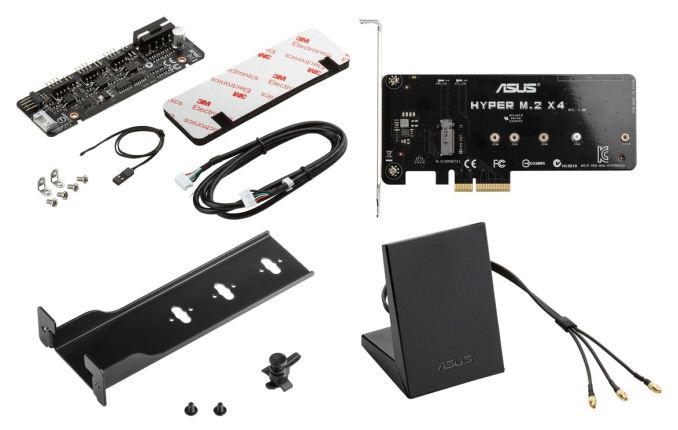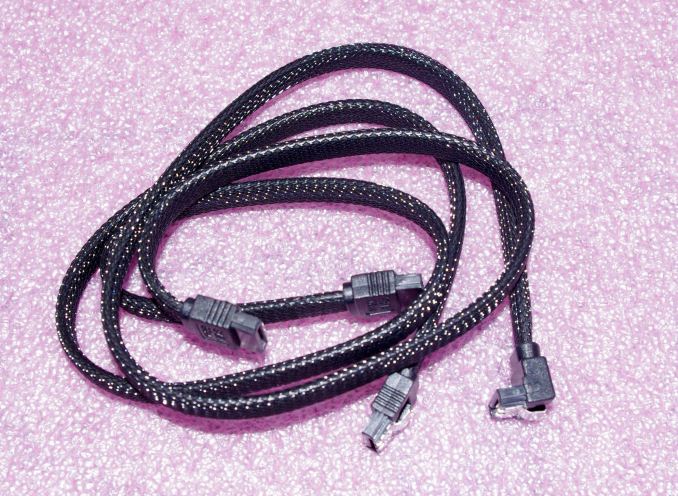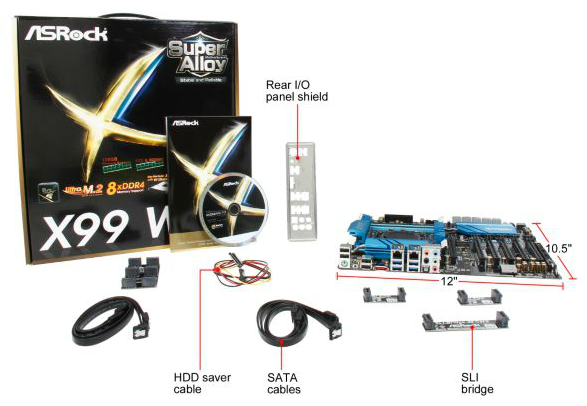The Intel Haswell-E X99 Motherboard Roundup with ASUS, GIGABYTE, ASRock and MSI
by Ian Cutress on September 25, 2014 11:30 AM ESTBox Contents and What to Expect
Over the years of reviewing motherboards, it is clear that the price of the overall package is a good indicator of what is inside the box. The cheaper motherboards below $100 rarely come with more than a couple of SATA cables, whereas the most expensive $500 comes with external goodies, like the Rampage IV Black Edition with the included OC Panel. Motherboard manufacturers often have a choice – strip the goodies out to make the product hit a lower price point, or invest in the end-user having an experience with the product as long as the extras make sense.
With X99, almost all the motherboards are in the high end category because X99 itself is a premium product, so we expect to see more than just SATA cables here. One of the common features with the gaming motherboards will be addition of licenses for gaming related software such as XSplit or even bundled games for certain regions.
ASUS X99-Deluxe In The Box
Due to the X99-Deluxe price point around $400, as well as the extra features like the vertical M.2 and Hyper x4 M.2, we get a fair amount of stuff:
Driver Disk
Manuals
Quick Installation Guide
Rear IO Shield
Vertical M.2 Brace and clips
Hyper M.2 x4 PCIe card
Wi-Fi Antenna for 3T3R
Fan Extension Card with adhesive
Two-pin Thermistor
3-Way SLI Flexible Connector
8 SATA Cables
In the past, ASUS has added extras into the box where they were not ultimately necessary – this time each addition is required to make something already on the motherboard to work. ASUS is still hedging its bets between SATA Express and M.2 however, with the vertical M.2 required to get extra functionality out of the limited PCB space.
GIGABYTE X99-UD7 WiFi In The Box
At around $310, the UD7 is just below the ASRock X99 WS in price but sits quite nicely in the middle of the X99 range between the super-high end and the low end of the spectrum. At certain points in the past GIGABYTE has given the user a reduced level of box extras in order to drive the price point of a motherboard down into another category, but that might not be so much of an issue here.
In the box we get:
Driver Disk
Manual
Rear IO Shield with LED Lighting
Flexi 2-way SLI Bridge
Short 3-way SLI Bridge
Long 3-way SLI Bridge
4-way SLI Bridge
Flexi 2-way Crossfire Bridge
WiFi Antenna
1 to 3 ATX 12V power cable
Six Sleeved SATA Cables
There is a healthy amount of SLI cables, including a long individual ones for three-way SLI with both 28 and 40 PCIe lanes CPUs. Adding the Crossfire bridge is a nice touch, as this seems to fly under everyone’s radar. Aside from the flashy IO shield and the antenna, one element stands out more than others: sleeved SATA cables!
This needs to be a thing in all motherboard boxes today. Even if it costs an extra $0.50 per motherboard for six cables (because manufacturers buy in bulk) I would certainly give this the thumbs up.
ASRock X99 WS In The Box
In our previous consumer oriented WS motherboard reviews, these types of motherboards are filled with SATA cables and SLI bridges to support multiple NVIDIA cards for compute. Workstation users might also require other connections from the COM or LPT adapters, depending on their use, although the ASRock X99 WS eschews those here in favor of its own HDD Saver cable.
In the box we get:
Driver Disk
Rear IO Panel
Manual
HDD Saver Cable for two SATA devices
Four SATA Cables
2-slot, 3-slot and 4-slot SLI bridges
ASRock is often generous with SATA cables, and previous levels of box contents have gone above and beyond the expected price point. At $324 this box bundle represents almost a bare minimum, and I would have expected a couple more SATA cables at least.
MSI X99S SLI Plus In The Box
Being the cheapest motherboard of the ones tested today, we would hazard a guess and say that it would be coming with the least kit included. $230 is in the middle to mid-high range for Z97 motherboards and might come with an extra free thing or two, but $230 is almost bottom of the pile for X99 and will most likely be treated as such. In the box we get the following:
Driver Disk
Manual
Rear IO Shield
Flexi SLI Bridge
Six SATA Cables
This is somewhat interesting. We have two more SATA cables than the ASRock motherboard, but it is odd that the X99S SLI Plus is designed around three-way GPU setups but we only get one SLI bridge in there. I would have assumed that users would be more interested in a three-way SLI Bridge than more SATA cables. However, because three-way SLI needs a strange way to connect them all, the extra cost of those cables might be prohibitive. Users will have to find SLI cables elsewhere for more than a 2-way graphics setup.















62 Comments
View All Comments
StephaneP - Friday, September 26, 2014 - link
On the Intel Motherboards, there was an onboard speaker. It was useful for hearing problems with Ram, Gpu, overheat, Fan fail...I don't see any speaker on these motherboards...
R3MF - Friday, September 26, 2014 - link
Re: the MSI X99S SLI Plus -"This means that with a 40 PCIe lane CPU, a user has to choose between tri-GPU (x16/x16/x8) + M.2 x2 from the chipset, or 2x GPU (x16/x16) + M.2 x4. 5820K users will get M.2 x4 in any configuration (x16/x8, x8/x8/x8)."
Do I understand this to mean that the same M.2 slot will switch between PCIe 2.0 PCH lanes and PCIe 3.0 CPU lanes depending on whether the last PCIe slot is used, and that 5820K users will always get PCIe 3.0 M.2 because the last PCIEe slot is not available for use at all?
Further from this; using a 5820k can i only use two PCIe slots if I want to maintain the first slot with 16x for the GPU, or are some of the slots run from the PCH and thus not affected by this.
I quite like the idea of a single GPU system (with 3.0 16x), a PCIe USB TypeC expansion card (with 3.0 4x), and possibly a third PCIe slot for a sound card. Is that possible with this board?
Thanks, great article.
Infn - Friday, September 26, 2014 - link
So purely performance-wise I still don't have much reason to upgrade from my 4.5ghz 3930K on X79. Is there anything on the horizon that will?woj666 - Friday, September 26, 2014 - link
Nope. You hit a great sweet spot with that system. Keep upgrading your GPU and you'll last a long time.StevoLincolnite - Friday, September 26, 2014 - link
Might want to update this article.X79 supports 4-12 core processors rather than 4-6, that you have listed.
I.E. For example the Asus Sabertooth X79 supports the 8-core Xeon E5-2640 v2 and the 10-core Xeon E5-2650L v2 as well as the 12-core Xeon E5-2697 v2.
Granted, consumers won't be running those Xeons, but the point stands, that you're not only limited to 4-6 cores on x79.
It's ironic because ALL Sandy-Bridge-E processors were actually 8-core processors, with 2 cores disabled, which helped with cooling due to the larger die meeting with the heat spreader.
Ivy Bridge-E however Intel reduced the core count down to 6.
extide - Saturday, September 27, 2014 - link
Except for the 3820K, that is a native quad core die. In moving to Ivy/22nm the base die for LGA 2011 went from 4 core to 6 core, and so for Ivy E all the CPU's were based on just the low end 6 core die, vs Sandy where they needed to use the 8 core die to get 6 cores.ludikraut - Friday, September 26, 2014 - link
I really hope you guys get an ASUS X99-E WS in to run through its paces. Some nice boards here, but just not in the same league feature and layout-wise.l8r)
Ian Cutress - Sunday, September 28, 2014 - link
I've made a note :) Going to try and clear the backlog so we can get some others in!Etern205 - Friday, September 26, 2014 - link
Sorry for the derail of this article, but has anyone notice Gigabyte also using some type of OC socket just like the Asus.http://www.legitreviews.com/gigabyte-ga-x99-soc-fo...
Ian Cutress - Sunday, September 28, 2014 - link
I have seen similar comments about this. The SOC Force LN2 board in that article is typically a limited run for extreme overclockers at GIGABYTE sponsored events. At this point we're not even sure exactly what ASUS or GIGABYTE is doing with the extra pins, or if they're doing different things with them. I have the standard SOC Force motherboard here, the one that end-users can buy, and it is using the standard X99 socket.